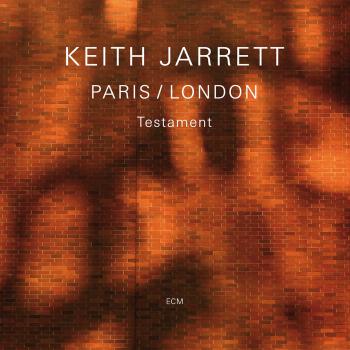
The Survivors' Suite Keith Jarrett
Album info
Album-Release:
2015
HRA-Release:
04.05.2015
Album including Album cover Booklet (PDF)
I`m sorry!
Dear HIGHRESAUDIO Visitor,
due to territorial constraints and also different releases dates in each country you currently can`t purchase this album. We are updating our release dates twice a week. So, please feel free to check from time-to-time, if the album is available for your country.
We suggest, that you bookmark the album and use our Short List function.
Thank you for your understanding and patience.
Yours sincerely, HIGHRESAUDIO
- 1 Beginning 27:21
- 2 Conclusion 21:18
Info for The Survivors' Suite
„One of the best recordings for Keith Jarrett's mid-'70s American quartet (whose style differed sharply from its European doppelgänger), Survivor's Suite opens with Jarrett's aching, breathy sigh on the bass recorder, evoking the sound of a horn somewhere across a great expanse of fog. Percussion soon punctuates the melodic line to give the opening a more spiritual, ritualistic feel, which is only the first of many mutations that this album will go through. Divided into two parts, entitled 'Beginning' and 'Conclusion,' this suite effortlessly flows between its movements which range from fiery free jazz to open, meditative atmospheric pieces showing heavy input from indigenous musics to instrumental solos that owe a sylistic debt to the music of the previous decade. Jarrett has strong solos in both the first and second track, but his performances rise to the surface frequently to add warmth to the suite. The greatest contribution that he makes on this album, however, is as a composer, as its complex components seem to nestle together seamlessly again and again, even if the solos occasionally rapidly expand and contract with kinetic energy. As strong a hand as Jarrett has in this album, however, he definitely owes a debt to his supporting players, especially the passionate Dewey Redman and skilled Paul Motian, but Charlie Haden plays an important role in the execution of the suite as well, even if only to provide a skeleton to hang the more fluid elements on. Like other albums of its time, this was beginning to show the brightness, lightness, and soft edges of contemporary jazz, but the solidness of Haden's bass helps keep it rooted and earthbound.“ (Stacia Proefrock, AMG)
Keith Jarrett, piano, soprano saxophone, bass recorder, celeste, drums
Dewey Redman, tenor saxophone, percussion
Charlie Haden, bass
Paul Motian, drums, percussion
Recorded in April 1976 at Tonstudio Bauer, Ludwigsburg, Germany
Engineered by Martin Wieland
Produced by Manfred Eicher
Digitally remastered
Keith Jarrett
At the end of 2008, Keith Jarrett added two concerts to his schedule at short notice – one at Paris’s Salle Pleyel (November 26), one at London’s Royal Festival Hall (December 1) . The music on “Testament” is from these concerts. Their range is compendious, Jarrett’s improvisational imagination continually uncovering new forms, in a music stirred by powerful emotions. In his liner notes, the pianist is forthright about the personal circumstances promoting a need to lose himself in the work once more.
He also reminds the reader/listener that “it is not natural to sit at a piano, bring no material, clear your mind completely of musical ideas and play something that is of lasting value and brand new.” This, however, has been the history and substance of the solo concerts since Jarrett initiated them, almost forty years ago . Over time their connection to ‘jazz’ has often become tenuous, yet Jarrett’s solo concerts, with the foregrounding of melody and the continual building, and relinquishing, of structure, are also removed from “free improvisation” as a genre. Jarrett’s solo work is effectively its own idiom, and has been subject to periodic revisions by the pianist. “In the early part of this decade, I tried to bring the format back: starting from nothing and building a universe.”
Since the “Radiance” album and the “Tokyo Solo” DVD of 2002 Jarrett has been adjusting the flow of the work, more often working with shorter blocks of material. “I continued to find a wealth of music inside this open format, stopping whenever the music told me to.” This approach distinguished “The Carnegie Hall Concert” (2006), and it is most effectively deployed in “Testament” , where the strongly-contrasting elements of the sections of the Paris concert in particular have the logic of a spontaneously-composed suite. The nerves-bared London performance (the first UK solo show in 18 years) is different again: “The concert went on and, though the beginning was a dark, searching, multi-tonal melodic triumph, by the end it somehow became a throbbing, never-to-be-repeated pulsing rock band of a concert (unless it was a church service, in which case, Hallelujah!).”
In the end, the improviser does what must be done. As Keith Jarrett said, a long time ago, “If you’re a rock climber, once you’re halfway up the face of the cliff, you have to keep moving, you have to keep going somewhere. And that’s what I do, I find a way.”
These days, however, Jarrett is rationing the number of ascents: there have been less than thirty solo concerts in the last decade, making “Testament” a special event indeed. Two further solo performances are scheduled for 2009 – at the Palais des Beaux Arts in Brussels on October 9, and at Berlin’s Philharmonie on October 12.
Booklet for The Survivors' Suite


























